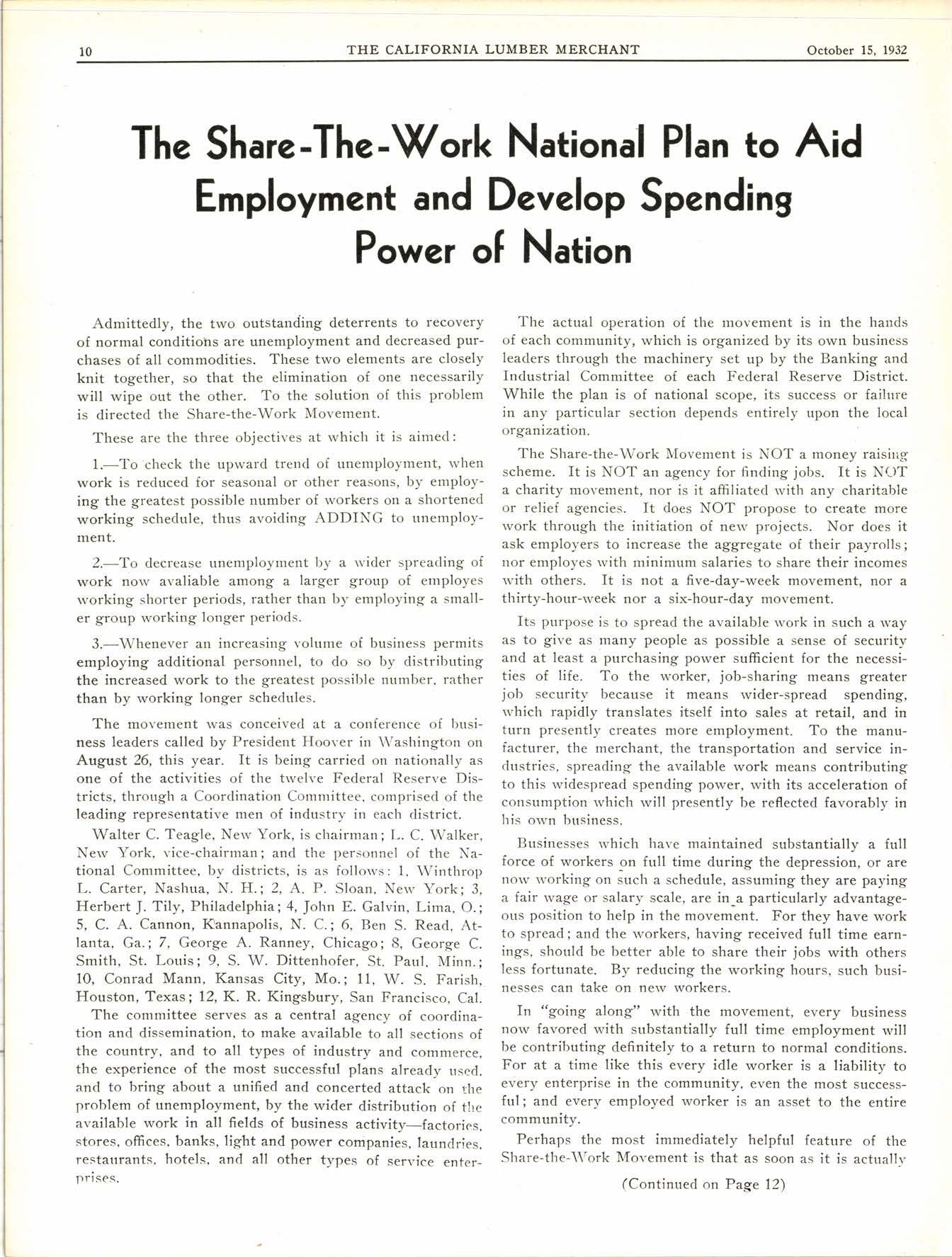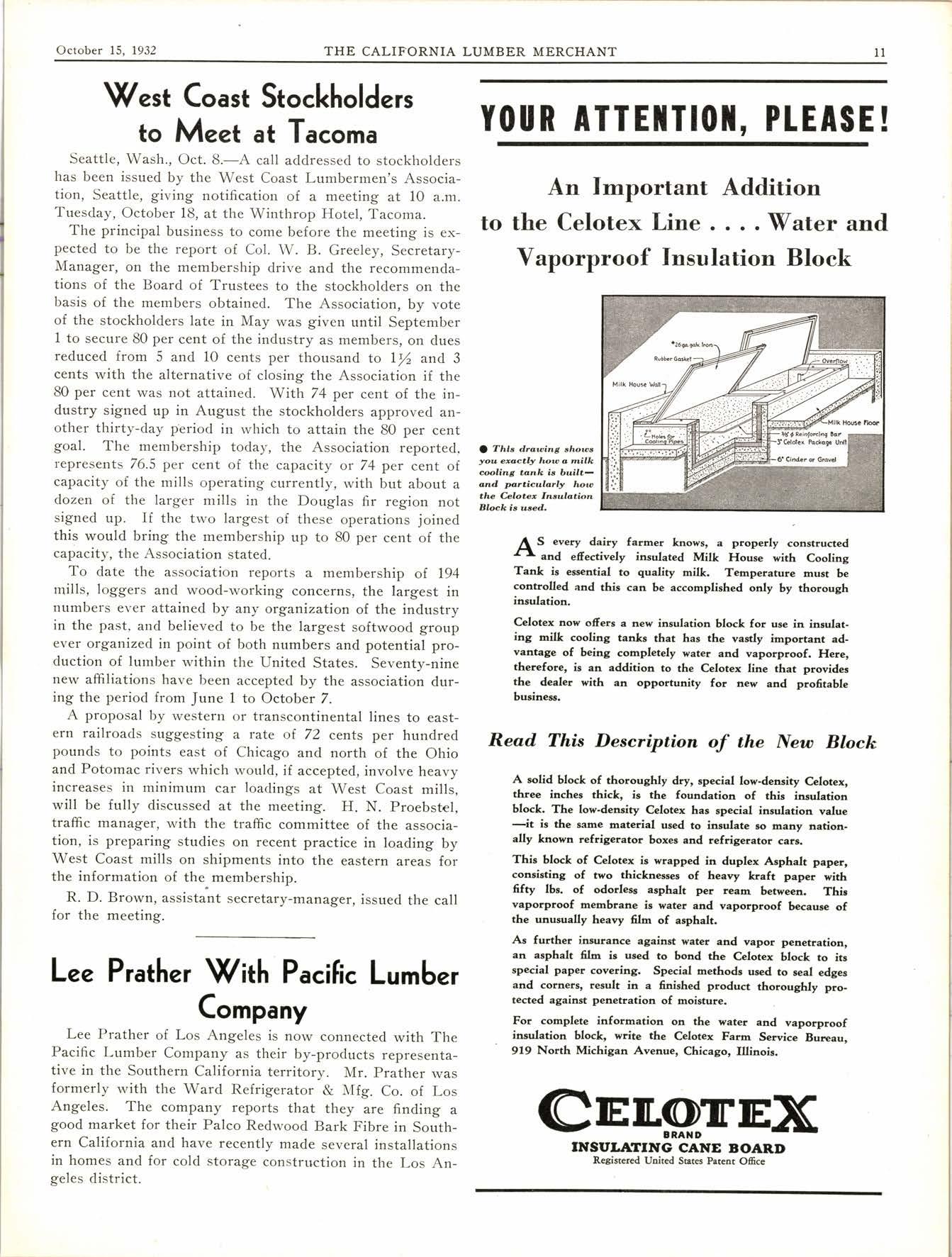
5 minute read
The Share-The-\(/ork National Plan to Aid Employment and Develop Spending Power of Nation
Admittedly, the two outstanding deterrents to recovery of normal conditiohs are unemployment and decreased purchases of all commodities. These two elements are closely knit together, so that the elimination of one necessarily will wipe out the other. To the solution of this problem is directed the Share-the-Work Movement'
These are the three objectives at which it is aimecl:
1.-To-check the upward trend of unemployment, when work is reduced for seasonal or other reasons, by employing the greatest possible number of workers on a shortened working schedule, thus avoiding ADDING to unemployment.
2.-To decrease unemployrnent by a wider spreading of work now avaliable among a larger group of employes working shorter periods, rather than by employing a smaller group working longer periods.
3.-Whenever an increasing volume of business permits employing additional personnel, to do so by distributing the increased work to the greatest possible number, rather than by working longer schedules.
The movement was conceived at a conference of business leaders called by President Hoover in Washington on August 26, this year. It is being carried on nationally as one of the activities of the twelve Federal Reserve Districts, through a Coordination Committee, comprised of the leading representative men of industry in each district.
Walter C. Teagle, Nerv York, is chairman; L. C. Walker, Nerv York, vice-chairman; and the personnel of the National Committee, by districts, is as follorvs: 1, Winthrop L. Carter, Nashua, N. H. ; 2, A. P. Sloan, Nelv York; 3, Herbert J. Tily, Philadelphia; 4, John E. Galvin, Lima, O.; 5, C. A. Cannon, K'annapolis, N. C.; 6, Ben S. Read, Atlanta, Ga.;7, George A. Ranney, Chicago; B, George C. Smith, St. Louis; 9, S. W. Dittenhofer, St. Paul. Minn.: 10, Conrad Mann, Kansas City, Mo.; 11, W. S. Farish, Houston, Texas ; 12, K. R. Kingsbury, San Francisco, Cal.
The committee serves as a central agency of coordination and dissemination, to make available to all sections of the country, and to all types of industry and commerce, the experience of the most successful plans already used, and to bring about a unified and concerted attack on the problem of unemployment, by the wider distribution of the available work in all fields of business activity-factories. stores, offices, banks, light and power companies, laundries, restaurants. hotels, and all other types of service enternrises.
The actual operation of the movement is in the hands of each community, which is organized by its own business leaders through the machinery set up by the Banking and Industrial Committee of each Federal Reserve District. While the plan is of national scope, its success or failure in any particular section depends entirely upon the local organization.
The Share-the-Work Movement is NOT a money raising scheme. It is NOT an agency for finding jobs. It is NC)T a charity movement, nor is it affiliated r,vith any charitable or relief agencies. It does NOT propose to create more work through the initiation of nerv projects. Nor does it ask employers to increase the aggregate of their payrolls; nor employes with minimum salaries to share their incomes rvith others. It is not a five-day-week movement, nor a thirty-hour-week nor a six-hour-day movement.
Its purpose is to spread the available work in such a way as to give as many people as possible a sense of security and at least a purchasing power sufficient for the necessities oflife. To the worker, job-sharing means greater job securitv because it means wider-spread spending, rvhich rapidly translates itself into sales at retail, and in turn presently creates more employment. To the manufacturer, the merchant, the transportation and service indttstries, spreading the available work means contributing to this widespread spending power, with its acceleration of consumption rvhich will presently be reflected favorably in his own business.
Businesses which have maintained substantially a full force of workers on full time during the depression, or are nor,v working on Juch a schedule, assuming they are paying a fair wage or salary scale, are in-a particularly advantageous position to help in the movement. For they have work to spread; and the workers, having received full time earnings, should be better able to share their jobs with others less fortunate. By reducing the working hours, such businesses can take on new workers.
In "going along" with the movement, every business now favored with substantially full time employment will be contributing definitely to a return to normal conditions. For at a time like this every idle worker is a liability to every enterprise in the community, even the most successful ; and every employed worker is an asset to the entire community.
Perhaps the most immediately helpful feature of the Sl-rare-the-\Vork Movement is that as soon as it is actuallv
(Continued on Page 12)
\fest Coast Stockholders to Meet at Tacoma
Seattle, Wash., Oct. 8.-A call addressed to stockholders has been issued by the West Coast Lumbermen's Association, Seattle, giving notification of a meeting at 1O a.m. Tuesday, October 18, at the Winthrop Hotel, Tacoma.
The principal business to come before the meeting is expected to be the report of Col. W. B. Greeley, SecretaryManager, on the membership drive and the recommendations of the Board of Trustees to the stockholders on the basis of the members obtained. The Association, by vote of the stockholders late in May was given until September I to secure 80 per cent of the industry as members, on dues reduced from 5 and 1O cents per thousand toll and 3 cents with the alternative of closing the Association if the 80 per cent was not attained. With 74 per cent of the industry signed up in August the stockholders approved another thirty-day period in .ivhich to attain the 80 per cent goal. The membership today, the Association reported. represents 76.5 per cent of the capacity or 74 per cent of capacity of the mills operating currently, with but about a dozen of the larger mills in the Douglas fir region not signed up. If the two largest of these operations joined this would bring the membership up to 80 per cent of the capacity, the Association stated.
To date the association reports a membership of 194 raills, loggers and wood-working concerns, the largest in numbers ever attained by any organization of the industry in the past, and believed to be the largest softwood group ever organized. in point of both numbers and potential production of lumber within the United States. Seventy-nine new affiliations have been accepted by the association during the period from June 1 to October 7.

A proposal by western or transcontinental lines to eastern railroads suggesting a rate of 72 cents per hundred pounds to points east of Chicago and north of the Ohio and Potomac rivers which would, if accepted, involve heavy increases in minimum car loadings at West Coast mills, will be fully discussed at the meeting. H. N. Proebstel, traffic manag'er, with the traffic committee of the association, is preparing studies on recent practice in loading by West Coast mills on shipments into the eastern areas for the information of the. membership.
R. D. Brown, assistant secretary-manager, issued the call for the meeting.
Lee Prather With Pacific Lumber ? Lompany
Lee Prather of Los Angeles is now connected with The Paciflc Lumber Company as their by-products representative in the Southern California territory. Mr. Prather was formerly with the Ward Refrigerator & Mfg. Co. of Los Angeles. The company reports that they are finding a good market for their Palco Redwood Bark Fibre in Southern California and have recently made several installations in homes and for cold storage construction in the Los Angeles district.










